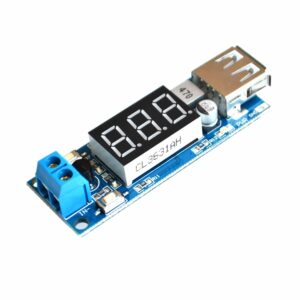6.5-40V To 5V 2A USB Charger
As with this USB Charger and many other electronics are certainly awesome little tools and trinkets, with each specific module or collection of predesigned Components ready to offer a different and often unique function. And while many of the modules available to us may perform very similar functions, we often find that even the ones that act, look and feel the same, offer subtle differences and variations that give it an edge in a specific niche.
This 6.5-40V To 5V 2A USB Charger is awesome little dual-function Modules, which are designed to take an input voltage of between 6.5V and 40V DC while offering a 5V Fixed Output for applications like charging smart devices, powering Development Boards and other 5V-based electronics projects, and gadgets. However, in addition to this (and this is how the module differentiates itself from many of the other Voltage Regulators that we stock), it is also designed to act as a voltmeter, capable of reading voltages between 4.5V and 40V with surprisingly good precision.
These features make this module quite unique compared to many of its rivals, as the fixed output makes it incredibly easy to step down almost any voltage into the 5V that you need, while also offering extra functionality that is handy for any Electronics Maker. So consider adding one of these fantastic little modules to your electronics toolkit, and start enjoying on-the-go Voltage Measurements and 5V fixed supply regardless of where you are or what supply you can get your hands on at the time.
USB Charger Specs:
- Input Voltage: 6.5V to 40V DC
- Output Voltage: 5V DC
- Max Output Current: 2A
- Input Required for Stable 5V min Input: 6.5V
- Onboard Buttons: Output Enable / Low Power
- Onboard Indicators: USB Output LED
- Voltage Display: 3x7-Segment Display
THREE SIMPLE STEPS TO CALIBRATING THE USB Charger:
After taking a look at and quality assuring a good range of these modules, these modules typically arrive fully calibrated and ready to function from the get-go. However, if you find that yours is slightly out of tune, or if you would like to calibrate it for a unique function aside from its standard purpose, calibrating the module is relatively simple and can be achieved in the following three easy steps:
- Step 1: With the voltmeter display active, begin calibration by pressing and holding the “Output Enable” button for 2 seconds, before releasing the button. The Voltmeter should begin to flash to let you know that you‘ve started the calibration mode.
- Step 2: Once in this calibration mode, press the “Output Enable” button to increase the voltage reading by 1 unit. Conversely, if you press the “Low Power” button, it will reduce the voltage reading by 1 unit. In this step, try to match the voltmeter reading to the voltage supply that you are providing it. Bear in mind that 1 unit in this mode is equal to 0.1V, allowing for high precision calibration.
- Step 3: Once you are happy with the calibration and accuracy of the voltmeter, simply press and hold the “Output Enable” button for 2 seconds again to exit the voltage calibration mode. Alternatively, if the board loses power (from unplugging it or any other reason) it will automatically save the calibration, which means you can simply remove the power source once calibration is done, although it is always recommended to allow the board to save calibration parameters while it is fully powered.
Remember that when calibrating high-precision Modules and components like these, that you utilize a Lab Power Supply or some kind of supply in which you know the exact voltages and currents that it’s supplying. This way, you can match the voltages exactly, and rest assured that your new voltmeter unit is ready to read exact voltages for your precise projects.
